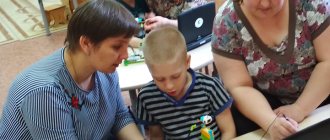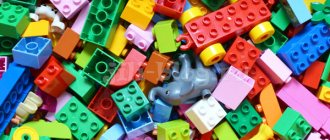Development of imagination in preschool children. It is impossible to imagine a child without imagination. The world of children differs significantly from that of adults because children are capable of inventing and thinking outside the box. The ability to imagine helps develop creative abilities, find ways out of difficult situations, and it is easier to adapt in real life if you direct your imagination in the right direction.
Features of the development of creative imagination in a preschool child
The baby takes his first steps towards the ability to use his imagination at the age of three. Play becomes part of the child, wherever he is: at home, on a walk, visiting, on a trip. During this period, the child begins to understand that one and the same object can play the role of several, if you use your imagination. Three- and four-year-old children begin to tell fairy tales - this awakens their previously dormant imagination. But they don't know how to plan. It is difficult to find out from such a child what he is going to draw if the child took pencils and paper. With the help of imagination, the drawing, of course, will be born, but the image of the future “picture” will be built in the process.
Until the age of five, preschool children still do not know how to direct their imagination, but at five or six years old they are already good inventors who can consciously decide what they want to play, what they need to draw, what craft they want to make. Once the goal is set, the work begins. Often, in play, children try to embody the experience they have gained, their impressions of watching a cartoon or a play, or some life scene.
Often children create their own special world if something in the real world does not suit them: difficult relationships with peers or adults, including parents; phobias that the child tries to fight in a self-invented way; problems that are easier to solve in a fantasy world.
In any case, the development of imagination is very important for a child. This is one of the levers with which a little person learns to interact with the world.
O.M. DYACHENKO
52
ABOUT THE MAIN DIRECTIONS OF DEVELOPMENT OF PRESCHOOL CHILDREN’S IMAGINATION
The problem of developing the imagination of a preschooler is still very controversial. When considering the essence of imagination, one can agree with E.V. Ilyenkov is that it lies in the ability to “grasp” the whole before the part, in the ability to build a holistic image on the basis of a separate hint [10]. Moreover, in a developed form, such a skill allows one to recognize generalized connections and patterns of the objective world and express them in specific symbolic forms [11]. A distinctive feature of imagination is, as S.L. rightly put it. Rubinstein, a kind of “departure from reality”, when a new image is built on the basis of a separate sign of reality, and not simply reconstructed and rearranged existing ideas, which is typical for the functioning of the internal plan of action. One of the main issues when considering the development of imagination is, in our opinion, the question of the specifics of the means that the child uses when creating products of the imagination. Delivered by L.S. For Vygotsky, the problem of the development of any human mental function as mediated, in our opinion, also arises when studying imagination. L.S. Vygotsky wrote that the essence of such development is
53
in the subject’s mastery of means that restructure and structure not the surrounding reality, but the mental functions themselves, and the main such means is the sign [4].
In later psychological studies (mainly work carried out under the direction of A.V. Zaporozhets) it was shown that in the process of development, special types of structured images (for example, sensory standards, model representations) can act as a means for the child. Mastering them, just like mastering signs, is associated with the assimilation of universal human experience [2], [15], [16].
The process of development of imagination is no exception; it obeys the general law of development of higher mental functions, i.e. imagination must develop through the inclusion of special means in the management of mastery.
Our previous studies made it possible to identify two main stages in the process of functioning of a preschooler’s imagination: 1) the generation of some idea of a creative product, 2) the creation of some plan for the implementation of this idea [8]. Both of these stages appear by the end of preschool childhood. Therefore, it is especially important to consider what is the specificity of the means by which the formation of a holistic process of imagination occurs throughout the entire preschool age.
The difficulty of analyzing this process, in our opinion, lies in the fact that there are two types and, accordingly, two main directions in the development of imagination. Conventionally, they can be called “affective” and “cognitive” imagination. An analysis of the affective imagination can be found in the works of S. Freud and his followers, where it is indicated that imagination and creativity are an expression of unconscious conflicts that are directly related to the development of innate tendencies. S. Freud wrote that the effect of creative behavior is the elimination of oppressive emotions that arise in conflict until a tolerable level is reached [19]. Neo-Freudians also believed that the main function of the imagination is to protect the individual, protect the “I,” and compensate for negative experiences that are generated not by unconscious processes, but by preconscious processes that record social conflicts of the individual [21].
These concepts have repeatedly been rightly criticized for exaggerating the role of biological tendencies in the development of the human psyche. Nevertheless, in these studies it was shown that imagination can act as a protective mechanism of the individual; the function of imagination was highlighted as resolving the contradiction that has arisen in the interaction of “I” and the environment. Moreover, the protection of the “I” can be carried out in two ways: through the subject’s mastery of his experiences during acting out, expressing them in creative products, and through the construction of an ideal “I”, an ideal situation that compensates for real failure.
Another direction in the development of imagination is J. Piaget’s research into “cognitive” imagination [22]. In them, imagination was associated with the development of the symbolic function in a child and was considered as a special form of representative thinking that allows one to anticipate changes in reality.
Some researchers have tried to merge these two directions of imagination development and talk about the affective nature of this process. Thus, even T. Ribot [17] pointed out the juxtaposition of intellectual and emotional factors in the imagination. L.S. Vygotsky in his research initially emphasized the affective nature of imagination: “The activity of imagination is a category of affects” [5; 69], and in later works, following T. Ribot, he pointed out the unity of emotional and intellectual components [3].
We assumed that two main types of imagination (affective and cognitive) coexist in the development of a child, have different tasks and different tendencies in implementation. For check
54
Based on our assumption, we developed the “Doll” technique, based on data from E.M. Gasparova on the development of director’s games in preschoolers [6]. The material used for the technique was five wooden dolls: three large and two small. Each doll was an unpainted cylinder-body with a ball-head. The child was given dolls and asked to figure out who they were and play with them as he wanted. The experiment was carried out individually. 76 children took part in it: 20 from the junior group, 20 from the middle group, 20 from the senior group and 16 from the preparatory group. The results obtained showed that it is indeed possible to distinguish two types of imagination: affective
and
educational.
The main task of cognitive imagination is a specific reflection of the objective world, overcoming contradictions that have arisen in the child’s ideas about reality, completing and clarifying a holistic picture of the world. With the help of imagination, children can either creatively master the patterns and meanings of human actions, or, starting from individual impressions of reality, build a holistic image of an event or phenomenon.
Affective imagination arises in situations of contradiction in the child’s image of reality and is in such cases one of the mechanisms for its construction. At the same time, on the one hand, imagination can perform a regulatory function in the process of assimilation of norms and meanings of social behavior. On the other hand, it acts as a protective mechanism for the individual. Protection can be carried out in two main ways: firstly, through multiple variable representation of traumatic influences, during which methods for resolving conflict situations may be found; secondly, through the creation of an imaginary situation that relieves frustration.
The results revealed that children with a predominance of either cognitive or affective imagination can be found in all age groups. How does the development of these two types of imagination and the formation of imagination as the highest mental function occur? When analyzing this issue, we were based on two types of data: 1) the results of a survey of more than 300 children from three to seven years old, obtained during the work of psychological consultation at the laboratory of psychology of preschool children of the Research Institute of Preschool Education of the Academy of Pedagogical Sciences of the USSR; 2) the results of experimental work aimed at identifying the specifics of performing imagination tasks and the possibilities of activating the imagination in preschool children (more than 250 children from three to seven years old).
The first stage in the development of imagination can be attributed to 2.5-3 years. At this age, the division of imagination into cognitive and affective, associated with the two most important new formations of age, occurs. On the one hand, this is the child’s separation of himself from the object, from the action with the object, and hence his focus on mastering new actions and objects, and if direct mastery is impossible, turning to substitute objects [18], [20]. On the other hand, the isolation of one’s personal “I”, the experience of one’s separation from the surrounding world [1], [13].
The data from our research show that already at this age the two types of imagination that we talked about can be clearly distinguished. This is cognitive imagination, revealed in those situations when a child, with the help of dolls, plays out some actions familiar to him and their possible variations (feeding children in kindergarten or at home, putting them to bed, walking, etc.), and affective imagination, manifested when playing a child of his experience. In this case, using different materials, children presented moments associated mainly with the experience of fear: threat, hiding, avoidance or non-avoidance of a threat (a policeman, or a wolf, or Baba Yaga lies in wait for disobedient
55
children and whether they are taken or not taken).
Similar material is provided by the work of psychological consultation, where, with the help of various methods, conversations with the child and parents, those moments of his games and, accordingly, imagination are revealed that are almost impossible to observe in kindergarten due to the specifics of the relationship between the teacher and children, the culture of object-based play, which given to children of this age. However, the director's play, which was identified in the study by E.M. Gasparova, is widely manifested at home and is very, often associated precisely with the affective imagination. In the case when parents play with a child at home, the child organizes exactly the kind of play that corresponds to the elimination of his affects.
So, a three-year-old boy always asks to play out the fairy tale “The Three Little Pigs” with him, where the most significant and role-played moments are the scenes of the wolf appearing and running away from him. The parents of a girl (3.3 years old), when asked about the supposed presence of fears, answer that she is very brave, is not afraid of anything, and plays Baba Yaga and the wolf all the time. There are many similar examples. It is important that the main task of the affective imagination appears here: protecting the individual, protecting one’s “I” from negative experiences that arise. Moreover, in the cases described, such protection is realized by acting them out, finding ways to resolve conflict situations in the game.
Note that it is probably the affective imagination that is associated from the very beginning with the use of symbols. In contrast to positive emotions associated in the child’s mind with specific events in reality, the source of negative experiences for a number of reasons is not recognized by the child, which leads to the use of symbols to express their negative experiences. Initially, these symbols are borrowed by children (Baba Yaga, Serpent Gorynych, etc.), and then created independently (a black flower, a toothy airplane, a fictional good or bad boy).
The second type of personal defense using imagination is the creation of an imaginary situation that relieves frustration. To paraphrase a well-known expression regarding childhood autism that there is no child who would prefer an imaginary apple to a real one, we can probably say that there is no child who would not prefer an imaginary apple to any apple. If the image of “I” is threatened, the child builds an imaginary situation that removes this threat. In it, he receives positive material to maintain the image of “I” in cases where he cannot reconcile the image of “I” with the requirements of reality. This mechanism is associated with children’s fantasy stories about how they are the strongest, how they defeated someone in the group, etc.
As we have already said, the process of imagination includes two stages: 1) generating an idea, 2) drawing up a plan for its implementation. The process of generating an idea as a simultaneous process of transforming information is associated primarily with the restructuring of images (the word is also included in this process). Our study showed that for the development of imagination, the decisive factors are the multi-contextual use of a word and the breadth of content in each context. In the presence of such factors, the word does not have a fixed content, but allows flexible manipulation with it.
Regarding the process of generating a plan for the implementation of an idea, it can be assumed that planning, being a successive process, is associated primarily with the planning function of speech [12]. However, just as speech processes are included in the stage of generating an idea for an imaginative product, imaginative processes can be included in the planning of a holistic product. The plan can be presented as a chain of images that models the main content [16]. A child’s level of planning is directly related to his ability to plan.
56
the ability to create holistic works.
There is reason to believe that at the described stage (2.5-3 years) a specific feature of the use of an image when generating the idea of an imaginary product is the construction of this image through the action of “objectification”. Individual impressions of reality are built up into a certain objective whole, and occupy a central position in this whole. For example, when completing the drawing of vague images, children turn a square into a house, a TV, a dog house, etc. Since the experience of children of this age is extremely variable (lack of stable general activity), their images can be distinguished by significant originality [7]. An “objectified” image becomes the first step in mastering the means of imagination as the highest mental function, since the possibility of using it allows the child to direct his imagination to solve the problem facing him.
As for planning products of the imagination, it is practically absent at this age. Imagination “creates” only an idea, and its successive unfolding usually only reproduces a familiar pattern with greater or less stability. The proposal to draw up an activity plan in advance and then act on it often led to the destruction of the activity, transition to a lower level, or abandonment of it. Thus, in an experiment with completing drawings of unfinished images, children in the younger group were asked to first tell what they would draw, and then draw. It turned out that almost all children who successfully completed the task of completing drawing without prior planning either abandoned the new task or descended to a lower level of its implementation (image of geometric figures or drawing next to a standard figure).
The second stage in the development of imagination is the age of 4-5 years. At this age, the child is aimed at mastering norms, primarily social ones, as well as rules and patterns of activity. Adults, sensing the child’s new capabilities, guide his education and upbringing mainly through models that the child must follow.
Partly due to the general orientation of children of this age, partly due to the peculiarities of pedagogical influences, the fact that the level of creative imagination at this age decreases. This was revealed both in our experimental study [7] and in the study of E. M. Gasparova, who points out the difficulty of creating an imaginary situation at this age. In her experiment, it was children 4-5 years old who refused to play with cubes with faces on them, citing the fact that they can only build with cubes; they build with cubes in the garden.
At this age, according to the work of psychological consultation, in healthy children the frequency of persistent fears decreases and usually the affective imagination of a healthy child arises in connection with his experience of real trauma. For example, a five-year-old boy, after undergoing surgery, “operated” on his teddy bear for a month, replaying versions of the most traumatic moments (anesthesia, removal of stitches, etc.). Stable internal conflicts most often manifest themselves in the construction of elementary substitute imaginary situations: children begin to invent stories about a bad boy who does all the pranks for them, invents friends for himself, etc.
The child’s cognitive imagination is associated with the rapid development of role-playing, drawing, and design at this age. But without special guidance, it is mainly of a reproductive nature, since a 4-5 year old child is aimed at following models. Deviations from patterns in the process of mastering them are possible, but they are of a playful, often random, undirected nature. Features of using the image
when generating ideas, products of imagination are that the image, like that of
57
for younger children, is built through the use of “objectification” actions, but then supplemented with various details. A word can be included in this process, causing or fixing the chain of ideas or generalizations behind it.
By the age of 4-5, the process of imagination includes specific planning, which can be called stepwise. The child plans one step of his actions, carries them out, sees the result and then plans the next step. This was evident in our experiments on finishing drawing, when the child was asked to first tell what he would draw, and then draw. If at a younger age such a proposal, as a rule, destroyed activity, then from 4-5 years old children move on to step-by-step planning. Children name one step of their plan (for example: “I’ll draw a house here”), implement it quite accurately (usually they give a schematic image of the house), and then, having seen the result, they begin to build a chain of transformations step by step from it (they supplement the image with details, draw something next to it) something else, etc.). Sometimes such step-by-step planning is reflected in the child’s loud speech: “I’ll draw a house,” “And now a pipe and windows,” then, “I’ll draw a girl next to the house,” etc.
The possibility of step-by-step planning leads children to the possibility of directed verbal creativity, when the child composes a fairy tale, stringing events one after another. But most often, the child takes as a basis the plan diagram of a familiar fairy tale, modifying the meaningful moments themselves (for example, the hare and the fox build huts not of bast and ice, but of bricks and snow, etc.).
The third stage in the development of a preschooler’s imagination is the age of 6-7 years. At this age, the child already masters the basic patterns of behavior and activities and gains freedom to operate with them. In principle, he is already able to deviate from the learned standards, combine them, using them in constructing products of the imagination.
The child’s affective imagination is aimed, on the one hand, as in the previous age, at overcoming the received psychotraumatic influences by repeatedly varying them in play, drawing and other creative activities. On the other hand, in cases of persistent conflict with reality, children often turn to a substitute imagination. It is at this age that fictional worlds with imaginary friends and enemies usually begin to exist. Opportunities for this are also created by the development of the ability to act figuratively, the development of internalized imagination. So, V.S. Mukhina described her son’s play when he lay silently for an hour among the arranged toys, and when asked what he was doing, he answered that he was playing with them, imagining everything they do [13]. A child’s creativity, especially at this age, is often projective in nature and symbolizes stable experiences. For example, in a consultation survey, a six-year-old boy brought up in a situation of overprotection, while completing a task to draw an imaginary animal, draws the Serpent Gorynych with spikes on his head. When asked by the experimenter about the purpose of the thorns, the boy replies that the Serpent Gorynych grew them for himself so that they would not sit on his head.
Cognitive imagination at this age undergoes qualitative changes. Children of six years old in their works not only convey processed impressions, but also begin to purposefully search for techniques for this transmission. The possibilities for choosing such techniques are directly related to the characteristics of a child’s learning, primarily to his mastery of the culture of play and elements of artistic creativity throughout preschool childhood. The possibility of choice is manifested not only in the selection of adequate methods for implementing products of imagination, conveying ideas, but also in the search for the idea itself, the plan.
At this age a new one appears
58
the ability to use the image when performing imagination tasks. A holistic image begins to be built using the “inclusion” method: it is still created on the basis of a separate element of reality, but this element begins to occupy not a central, but a secondary place, and becomes a separate detail of the image of the imagination. For example, when completing unfinished images, the same square turns into a brick, which is lifted by a crane [7]. The possibility of using the products of imagination in precisely this way when creating ideas provides multivariate solutions to problems, which rebuilds and directs the process of imagination towards the search and selection of the optimal solution. It is quite obvious that such a search is also present in the developed creative process of an adult. A word can be successfully included in the process of generating an original idea in the case when it is not backed by a strictly defined idea or a narrow circle of generalizations.
Here, too, holistic planning appears for the first time: the child can, before beginning actions, construct a plan for their implementation (in the case of imagination, a plan for developing the idea of a work) and consistently implement it, often adjusting it as it progresses. At this age, when completing the task of completing drawings with previous speech planning, children often provide a complete multi-step plan for the work. For example: “I’ll draw a house here, there’s a garden near the house, and a girl walks around and picks flowers” or: “I’ll draw the New Year. The Christmas tree is standing, next to Father Frost and the Snow Maiden, and under the tree there is a bag of gifts.” Almost all children of this age accurately implement their plans, usually supplementing them with various details in the process of execution.
The last question I would like to dwell on is the question of pedagogy for the development of imagination. The stages of development of imagination as an indirect function described here represent only the possibilities of each age, which, under natural conditions, are realized, unfortunately, by a minority of children (approximately 1/5 of children of each age).
Without specific guidance, the development of imagination may have an unfavorable prognosis. Affective imagination without sufficient, usually spontaneously emerging, recovery from trauma can lead to pathological stagnant experiences (obsessive fears, anxiety) or lead the child to complete autism, to the creation of a substitute imaginary life, rather than real creative products. Cognitive imagination tends to gradually fade away, since its functioning, as rightly noted by A.V. Petrovsky, is associated with those situations in which the uncertainty is very great [14]. Focusing education on the certainty of the knowledge a child receives, the unambiguousness of his answers to all questions, and the assimilation of ready-made schemes for transforming reality lead to a decrease in the role of imagination, and then to its almost complete disappearance in many children in the school system.
The culture of emotional life (the ability to empathize, sympathize, feel for a situation), as well as mastery of various other elements of universal human culture (knowledge of certain contents, mastery of elements of techniques for performing various types of activities), are only necessary conditions for the full development of the child’s imagination.
One of the main lines of imagination pedagogy should be aimed at mastering the child, regardless of the specific material, with the basic means that rebuild the function of imagination and direct it to the creation of holistic creative products and the solution of real creative problems. The main means of constructing a holistic product of imagination are, in our opinion, images constructed in various ways, and the meanings of words included in various
59
contexts and related to a fairly broad content, as well as plans for creating integral products of the imagination, generated and recorded primarily in the child’s speech activity or in the form of an image-model of a future work. Mastering such means, as E.V. rightly points out. Ilyenkov [10], can go through interaction with those objects of universal human culture that are created by the power of imagination, as well as through the development of the symbolic function in various types of children's activities, which the child masters with the help of an adult who conveys to him the forms and methods of “meaning” reality.
Let us also note that the very practice of solving imagination problems causes significant changes in the child’s personality, allowing him to openly realize his affective and cognitive tendencies. With the right pedagogical guidance, these tendencies can merge and be embodied in real creative products. Support and flexible assessment of the products of a child’s imagination set a focus on socially significant self-realization and open up positive opportunities for the development of full-fledged creative activity.
1. Burns R.
Development of self-concept and education. M., 1986. 422 p.
2. Wenger L. A.
Perception and learning. M., 1969. 365 p.
3. Vygotsky L.S.
Imagination and creativity in childhood. M., 1967. 93 p.
4. Vygotsky L.S.
Collection cit.: In 6 vols. T. 3. M., 1983. 368 p.
5. Vygotsky L.S.
Psychology of art. M., 1968. 276 p.
6. Gasparova E. M.
Psychological features of changes in the content of gaming activity at the turn of early and preschool age: Abstract of thesis. Ph.D. dis. M., 1985. 25 p.
7. Dyachenko O. M., Kirillova A. I.
On some features of the development of imagination in preschool children // Issues. psychol. 1980. No. 2. P. 107-114.
8. Dyachenko O. M.
Ways to activate the imagination of preschoolers // Issues. psychol. 1987. No. 1. P. 44-51.
9. Zakharov A. I.
Psychotherapy of neuroses in children and adolescents. L., 1982.
10. Ilyenkov E. V.
Art and the communist ideal. M., 1984. 349 p.
11. Lifshits M.
Mythology ancient and modern. M., 1980. 582 p.
12. Luria A. R.
Language and consciousness. M., 1979. 320 p.
13. Mukhina V.S.
Child psychology. M., 1985. 272 p.
14. General psychology / Ed. A. V. Petrovsky. M., 1976. 479 p.
15. Poddyakov N. N.
Preschooler thinking. M., 1977. 272 p.
16. Development of cognitive abilities in the process of preschool education / Ed. L.A. Wenger. M., 1986. 224 p.
17. Ribot T.
Creative imagination. 1901.
18. Slobodchikov V. I.
Psychological Problems of the formation of a person’s inner world // Issues. psychol. 1986. No. 6. P. 14-22.
19. Freud Z.
Leonardo da Vinci. M., 1912.
20. Elkonin D. B.
Psychology of the game. M., 1978. 304 p.
21. But r peu
K. _
Our Inner conflicts. NY, 1966.
22. Piaget J.
La formation du symbole chez 1'enfant. Neuchatel, Delachaux et Niestle, 1945. 308 p.
Received by the editors on April 18, 1988.
Types of imagination
Experts distinguish several types of imagination.
Creative
Human consciousness allows you to compose incredible images, without relying on knowledge and experience. Such imagination, with its further development, can even become the basis for a person’s future profession related to writing.
Recreating
This type of imagination is based on existing knowledge; images that the child became acquainted with in classes, in communication with relatives and friends appear from memory and are developed.
Wild fantasy
Uncontrolled imagination, where reality and fantasy replace each other. The child constantly thinks about something and declares that all this actually happened.
What is the difference between fantasy and imagination?
First of all, let's understand the very concepts of fantasy and imagination. In the understanding of most people, these terms are identical, but in fact they are fundamentally different things.
Fantasy is a certain imagined situation that has nothing to do with reality. For example, flying unicorns or the tooth fairy are nothing more than children's fantasies.
But imagination is the ability to consciously form certain images of reality and manage them. What is important is that these images correspond to reality and do not contradict it in any way. For example, a child may imagine how he answers brilliantly in class or solves a difficult problem, becomes the owner of a huge house or gets a dog. Thus, imagination is the idea of what may well happen.
Fantasy is the idea of something that cannot happen in reality. For clarity, we present a comparative table of fantasy and imagination.
| Fantasy | Imagination |
| A situation far from reality | A situation based on reality that can develop |
| It remains a fiction | Could come true |
Obviously, from a practical point of view, imagination is more important. This is the child’s creativity, his creativity and ability to simulate specific situations.
The most important thing is to improve a child’s creative imagination, but it is closely intertwined with fantasy. Therefore, it is necessary to develop both of these directions. What will this do for your child?
- he solves non-standard problems more easily and learns to find the optimal solution in unpredictable situations;
- he adapts to life and understands his place in it;
- he learns to think, make decisions and see their consequences.
Although fantasies are groundless inventions, they are a source of inspiration and joy for a child. There is no need to greatly limit him in his fantasies. The main thing is that fictional images do not separate him from real life, but, on the contrary, enrich it.
Methods and techniques for developing imagination in preschool children
Since healthy imagination is important for the harmonious development of a child, adults should help develop this imagination correctly.
There are several effective techniques. They are based on the development of the child’s creative abilities, as well as his mental activity.
This:
- Applied activities,
- Literature classes,
- Didactic games,
- Development of horizons,
- Development of tactile abilities,
- Art, music, dance classes.
Applied activities are one of the methods not only to awaken a child’s imagination, but also to direct him in the right direction. So, drawing or modeling classes will help teach your child to come up with and implement an idea. Construction will make it possible to create something fantasy, but this object can already be touched, it can become the object of games. Let the child come up with things that do not exist in the real world, but this is much more interesting. A fictional thing may have characteristics that the author himself gives it.
A good option to develop imagination is fairy tales that the child himself composes. An adult just needs to help, give a start to imagination. Let this be a simple story, the very beginning. And only then the child must figure out what will happen to the characters next, what adventures await them. And if a child comes up with a fairy tale and draws at the same time, clearly showing the plot, even better.
Didactic games play a great role in the development of imagination. An experienced teacher can interest a child by inviting him to study and play at the same time.
So, you can use the following techniques.
Chance to become unique
In fact, from birth, every baby is initially gifted with the ability to fantasize, create, and imagine.
But over time, “good” fathers and mothers decide that their child does not need all this. Therefore, they begin to intensively develop logic and analytics in them, and teach them “useful and necessary for our harsh life.” But this is fundamentally wrong. Undoubtedly, a person who has a lot of useful knowledge and skills in life, no matter how harsh it is, will not be lost. But life will not be good either.
Therefore, by developing our baby’s imagination, feeding his fantasy, we give him an amazing chance to become a unique person.
Developing imagination through non-traditional drawing
Unconventional drawing methods are unusual, interesting and useful. The child learns to see the miraculous in the most ordinary things. So, he learns that, it turns out, you can draw, for example, with your palms, a comb and a sponge, and not with a brush, with biscuit cream, and not just with paints. This awakens the imagination, the child has a desire to try new and unknown things.
Here are the simplest ways to draw unconventionally:
- Drawing with a candle.
- Drawing with splashes through a straw.
- Drawing with stamps made from bottle caps, sponges, chewed paper.
- Finger painting.
- Isothread: the thread is dipped into the paint, pressed against the paper, and the resulting print can be expanded into a real design.
- Drawing with a comb.
- Drawing with a cotton swab.
- Children of any development will enjoy drawing this way. Moreover, some methods help in the prevention of certain diseases, as well as in the correction of speech, breathing, and vision.
Development of imagination by means of construction
There are many construction sets on sale that both children and adults enjoy playing with. Of course, there is no need to set complex design tasks for the child. But construction kits with proposed assembly schemes can be the start of an interesting hobby for a child. And if an adult gets involved in the design, then the design itself can turn into a game.
Design helps:
- develop spatial imagination,
- gain knowledge about shape, size, the first rudiments of knowledge about geometry,
- develop fine motor skills, which is useful for the development of thinking,
- develop independence, perseverance,
- develop imagination.
It will be useful for preschoolers to play with cubes, which will allow them to get a first idea of shape, color, size; mosaic, which teaches you to pay attention to little things; block constructors that create three-dimensional objects for games; Lego, with the help of which children become acquainted with 3D modeling skills.
Ability to make non-standard decisions
In the end, it doesn’t matter what profession he chooses or what life situations he finds himself in. A developed imagination will allow you to make non-standard decisions. And also to highlight nuances that are unnoticed by others, to look at any problem as if in 3-D format.
Thus, dear parents of a preschooler, right now you have a choice: do everything according to the rules.
- Teach to read, write, stand up for yourself, fight back, become independent, etc.
- Take a different path and raise an extraordinary, confident, and thinking person.
So, remember that “without imagination, there is no consideration” (folk wisdom).
Imagination disorders and their causes
Children may suffer from a lack of imagination or, on the contrary, their imagination becomes uncontrollable.
Imagination deficits are usually experienced by children with speech impairments, because speech and thinking and imagination are interconnected. With speech pathology, the child thinks primitively, he is not able to create a new image, he cannot invent, compose, and also carry out tasks of an adult where he needs to use his imagination. These children usually have difficulty remembering terms, assimilating the acquired knowledge, and do not understand symbols.
Children who have low self-esteem may also have a deficit of imagination. They are afraid of doing something wrong, they are absolutely deprived of independence, which suppresses imagination.
In this case, teachers need to creatively overcome the child’s inhibition step by step, offering to develop abilities through play, the basis of which will be a situation familiar to the child. A good way out of this situation would be the theater. You also need to focus on cognitive activities to broaden the child’s horizons. Emphasis on emotions will play a big role. What impressed you will leave a mark on your soul, and you will want to learn more about it.
Violent fantasy, which can manifest itself in aggression, lies, fears, and the replacement of the real world with a fantasy world, can also interfere with the normal productive development of the imagination.
The reasons for this inadequate imagination may be the child’s internal fears, problems he has with family and peers, inability to get along with the outside world, as well as other psychological problems.
In this case, it is advisable to contact psychologists who will help create an individual program to eliminate the pathology.
What influences the development of a child’s imagination
In order for the development of a child’s imagination to proceed correctly, it is necessary to create a comfortable atmosphere in which the child will learn to fantasize with pleasure and benefit, but will not cross the dangerous line between reality and the illusory world.
- Develop speech, since thought processes are associated with speech functions.
- Pay attention to the development of the child's fine motor skills. The more actively a child works with his hands, the better he speaks and thinks.
- Eliminate loneliness, which, in turn, will eliminate the need for the child to create imaginary friends.
- It is important to increase a child’s self-esteem, not by comparing him with other peers, but by comparing him only with himself, based on his achievements and actions.
- Trusting relationships with parents play a big role. If a child is not afraid of punishment, then he will not have to lie. But you can encourage creative writing - fairy tales, stories, drawings, crafts.
- There should be a lot of creativity in a child's life. These activities stimulate the imagination.







